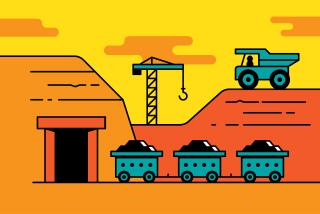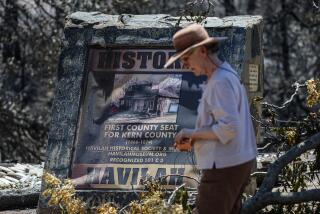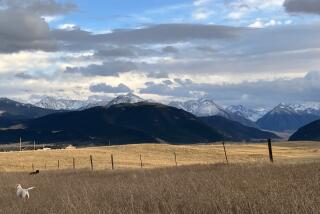Fading Ghost : Gold-Mining Town of Rhyolite Is Losing Battle Against Nature and Vandals
RHYOLITE, Nev. — Is Rhyolite, one of the most photographed ghost towns in the West, gasping its last breath?
The turn-of-the-century gold camp is today a collection of remnants.
The stark concrete building skeletons, a checkerboard of old foundations, the town’s famed “bottle house” and railroad depot combine with fascinating lore about the town’s riotous history to attract thousands of visitors each year. The bleak, eerie locale has the distinction of being the only ghost town in the Death Valley area easily accessible by car.
But the ravages of time, vandalism and the resumption of mining activity threaten the town’s existence.
“Rhyolite is deteriorating rapidly. If something isn’t done soon the old gold-mining town may become a memory,” said Debbie Stetz, 35, a technician at the Death Valley National Monument museum and secretary of Friends of Rhyolite.
The group was formed last January after several bottles and mortar broke loose and fell mysteriously from under the rafters of the ghost town’s bottle house, creating a huge hole in the historic building. Saloonkeeper Tommy Kelly had mixed mortar and cemented in 31,000 Anheuser Busch beer bottles to fashion the walls of his unusual home in 1906.
When the hole in the bottle house was discovered, 50 people concerned about the well-being of the ghost town met in nearby Beatty, Nev., and formed Friends of Rhyolite.
The group was organized to find ways to preserve and stabilize what little is left of the old town and to save it from disappearing forever.
Friends of Rhyolite is planning the “Resurrection of Rhyolite” Jan. 18-19 to publicly launch its campaign to preserve and protect the ghost town.
“It will be a weekend of living history with tours by costumed guides explaining what Rhyolite was like during its heyday. There will be photographic exhibits (and) re-enactment of life in the gold camp,” said Stetz.
Rhyolite--up the steep grade of Death Valley’s Daylight Pass high on the shoulders of the purple Bullfrog Mountains--is two miles east of the national monument’s boundary and five miles west of Beatty.
The hills behind the crumbling ruins of the once roaring gold camp are scarred with the diggings of 10,000 men who recovered millions of dollars of the precious metal for three halcyon years--1905-1908--when Rhyolite was the third biggest town in Nevada.
Rhyolite boasted 48 saloons, three banks, a schoolhouse, 42 streets lined with framed homes and a huge depot handling passengers and freight for three railroads--the Las Vegas & Tonopah, Tonopah & Tidewater and Bullfrog & Goldfield.
In the intervening years all the old homes and commercial buildings fell apart or were hauled away, except for three striking stone skeletons--the John Cooke bank building, the schoolhouse and the Porter Bros. general store. Also remaining are the bottle house, the depot, a tiny jail and a handful of residences, two still standing and livable and the rest weathering away.
Rhyolite has only one year-round resident, Lou Schuh, 53, who leaves the ghost town each day at sunup to work on a distant ranch and doesn’t return to his trailer until late in the evening. From October through May, Verna Lewis, 70, and her husband, Delbert, 72, run a gift shop in the rock-and-mud house where Louise Morrison, Verna’s aunt, lived from 1929 until her death in 1976.
Lack of security has been a major problem in the town. Fences have been erected around the depot and bottle house to protect the structures from thieves and vandals. “Everything in the depot including the bathtub has been ripped off,” said Britt Johnson, 36, manager of the Angst Mining Co. operators of Gold Bar gold mine four miles from Rhyolite, owners of the majority of mining claims in Rhyolite and owners of the depot.
“People have stolen most of the tombstones and headboards in the cemetery.”
Except for a half-dozen holdings, Rhyolite is on federal land with mining companies holding claims to exploit mineral resources.
“According to mining laws the mining companies are in the drivers’ seat as far as Rhyolite is concerned,” said Ted Angle, area manager for the U.S. Bureau of Land Management. “There is nothing to stop the mining companies from dismantling and removing the structures still standing in Rhyolite to access the ore beneath the ground.”
The one exception is the bottle house, which stands on four acres of land owned by the bureau and withdrawn from mining claims.
Members of the Friends group are concerned that the jostling from the mining activity will further damage the fragile structures.
Kari Coughlin, 42, Death Valley National Monument ranger, is chairwoman of Friends of Rhyolite. She believes the two mining companies active in the area “have a great opportunity of becoming Rhyolite’s heroes--with mining companies being both builders and saviors of the town.”
But some mining officials say they have not decided how to proceed. Johnson, for example, noted that the ruins of the three stone structures are a hazard and could topple at any time.
“I was born and raised in Bisbee, Ariz., an old mining town. I believe in preserving as much of the history of the Old West as possible,” said Johnson. “What to do with what’s left of Rhyolite is a tough call. The bottle house is extremely important as an historic structure and definitely needs to be preserved and restored. I think it should be moved to Beatty.”
A mile south of the ghost town another firm, Lac Minerals Ltd., based in Toronto, employs 320 miners (a $1 million-a-month payroll) removing gold and silver from Ladd Mountain. Lac Minerals also has claims in Rhyolite.
Jack Bingham, 49, manager of Lac Minerals, has been attending the monthly Friends of Rhyolite meetings in Beatty. “I want to see Rhyolite remain as it is just as much as the Friends of Rhyolite do,” Bingham said. “I’m convinced it’s possible to mine underground beneath the structures still standing in Rhyolite without causing damage to them.”
Coughlin, is hoping the mining companies will cooperate in the effort to save Rhyolite. “If we can save Rhyolite everybody will look good--the mining companies, the BLM, Death Valley, Beatty.”
Ghost Town
Some Nevada residents are trying to save the ghost town of Rhyolite, which they fear is being threatened by the ravages of timek, vandalism and mining activity nearby.
More to Read
Sign up for Essential California
The most important California stories and recommendations in your inbox every morning.
You may occasionally receive promotional content from the Los Angeles Times.










